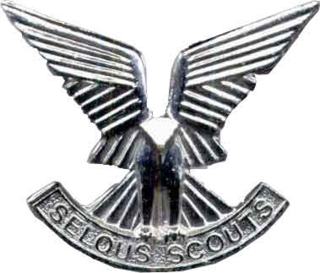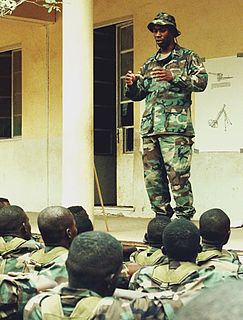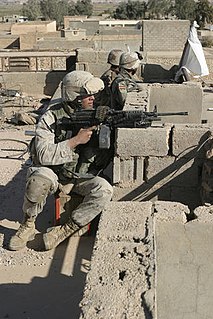
Guerrilla warfare is a form of irregular warfare in which small groups of combatants, such as paramilitary personnel, armed civilians, or irregulars, use military tactics including ambushes, sabotage, raids, petty warfare, hit-and-run tactics, and mobility, to fight a larger and less-mobile traditional military.

Close-quarters combat (CQC) or close-quarters battle (CQB) is a tactical situation that involves a physical fight with firearms involved between multiple combatants at quite short range. It can occur between military units, police/corrections officers and criminal elements, and in other similar situations. In warfare, it usually consists of units or teams of varying size engaging the target or attacking personnel with personal weapons within a distance of up to 100 meters, from proximity hand-to-hand combat to close-quarter target negotiation with usually automatic weapons. In the typical close combat scenario, the attackers try a very fast, violent takeover of a vehicle or structure controlled by the defenders, who usually have no easy method to withdraw. Because attacking and defending personnel, hostages/civilians, and friendly personnel can be closely intermingled, close-quarters combat demands a rapid assault and a precise implementation of lethal force. The operators need obvious, sufficient proficiency with their weapons, and the ability to make quick decisions in order to limit friendly casualties and raise the likelihood of operational success.

The Selous Scouts was a special forces unit of the Rhodesian Army that operated during the Rhodesian Bush War from 1973 until the reconstitution of the country as Zimbabwe in 1980. It was mainly responsible for infiltrating the black majority population of Rhodesia and collecting intelligence on insurgents so that they could be attacked by regular elements of the security forces. The unit did this by forming small teams that posed as insurgents and usually included captured insurgents. Over time, the Selous Scouts increasingly attacked insurgents themselves and operated in the countries that neighboured Rhodesia.

The Strategic Hamlet Program was a plan by the government of South Vietnam in conjunction with the US government and ARPA during the Vietnam War to combat the communist insurgency by pacifying the countryside and reducing the influence of the communists among the rural population.

The 2003–2006 phase of the Iraqi insurgency began following the completion of the invasion of Iraq and the toppling of Saddam Hussein's rule in May 2003. The armed insurgent opposition to the U.S.-led multinational force in Iraq and the post-2003 Iraqi government lasted until early 2006, when it escalated into a civil war, the most violent phase of the Iraq War.
Jungle warfare is a term used to cover the special techniques needed for military units to survive and fight in jungle terrain.

The Second Battle of Fallujah—code-named Operation Al-Fajr and Operation Phantom Fury—was a joint American, Iraqi-government, and British offensive in November and December 2004, the highest point of conflict during the Iraq War. It was led by the U.S. Marines against the Iraqi insurgents in the city of Fallujah, and was authorized by the U.S.-appointed Iraqi Interim Government. The U.S. military called it "some of the heaviest urban combat U.S. Marines have been involved in since the Battle of Huế City in Vietnam in 1968."

Counterinsurgency (COIN) is "the totality of actions aimed at defeating irregular forces". The Oxford English Dictionary defines counterinsurgency as any "military or political action taken against the activities of guerrillas or revolutionaries" and can be considered war by a state against a non-state adversary. Insurgency and counterinsurgency campaigns have been waged since ancient history. However, modern thinking on counterinsurgency was developed during decolonization. Within the military sciences, counterinsurgency is one of the main operational approaches of irregular warfare.
Operation Sinbad was an operation led by the Iraqi Security Forces and supported by British, Danish and other Multi-National Forces in southern Iraq. The operation began during the early hours of 27 September 2006. The stated goal of the operation was to root out corrupt police as well as offer assistance to the residents of the area in rebuilding. An estimated 2,300 Iraqi army troops and 1,000 British soldiers took part in the operations with another 2,000 in close proximity, in preparation for handing over security of the city of Basra to the Iraqi government.

The Battle of Mosul was a battle fought during the Iraq War in 2004 for the capital of the Ninawa Governorate in northern Iraq that occurred concurrently to fighting in Fallujah.
Operation Warrior's Rage was a United States and Iraqi Army cordon-and-search operation during the US occupation of Iraq. The operation was performed on the evening of 15 July 2005.

Foreign internal defense (FID) is a term used by the militaries of some countries, including the United States, France, and the United Kingdom, to describe an integrated and synchronized, multi-disciplinary approach to combating actual or threatened insurgency in a foreign state. This foreign state is known as the Host Nation (HN) under the US doctrine. The term counter-insurgency is more commonly used worldwide than FID.
Operation Phantom Phoenix was a major nationwide offensive launched by the Multinational Force Iraq (MNF-I) on 8 January 2008 in an attempt to build on the success of the two previous corps-level operations, Operation Phantom Thunder and Operation Phantom Strike and further reduce violence and secure Iraq's population, particularly in the capital Baghdad. The offensive consisted of a number of joint Coalition and Iraqi Army operations throughout northern Iraq as well as in the southern Baghdad Belts.
The 2008 Nineveh campaign was a series of offensives and counter-attacks between insurgent and Coalition forces for control of the Nineveh Governorate in northern Iraq in early-to-mid-2008. Some fighting also occurred in the neighboring Kirkuk Governorate.
In United States military doctrine, unconventional warfare is one of the core activities of irregular warfare. Unconventional warfare is essentially support provided by the military to a foreign insurgency or resistance. The legal definition of UW is:
Unconventional Warfare consists of activities conducted to enable a resistance movement or insurgency to coerce, disrupt or overthrow an occupying power or government by operating through or with an underground, auxiliary or guerrilla force in a denied area.

The Special Forces Qualification Course (SFQC) or, informally, the Q Course is the initial formal training program for entry into the United States Army Special Forces. Phase I of the Q Course is Special Forces Assessment and Selection (SFAS). Getting "Selected" at SFAS will enable a candidate to continue to the next of the four phases. If a candidate successfully completes all phases they will graduate as a Special Forces qualified soldier and then, generally, be assigned to a 12-men Operational Detachment "A" (ODA), commonly known as an "A team." The length of the Q Course changes depending on the applicant's primary job field within Special Forces and their assigned foreign language capability but will usually last between 56 and 95 weeks.

Operation Sayeed also known as Operation Hunter in English, was a series of operations conducted in western Al Anbar Governorate by the United States Marine Corps in 2005. It was an umbrella operation, consisting of at least 11 named operations between July 2005 to December 2005. The purpose was to drive Al-Qaeda in Iraq forces from the Western Euphrates River Valley. Some parts of Operation Sayeed were Operation Steel Curtain and Operation Iron Fist.

Operation Shark was a counter-terrorism operation conducted by the military and police forces of British Mandatory Palestine in response to the King David Hotel bombing. Conducted through a series of house to house searches, the operation was intended to deprive the Irgun organization of manpower, hideouts, and weaponry.

The Killing of Qusay and Uday Hussein occurred during an American military operation conducted on July 22, 2003, in the city of Mosul, Iraq. The operation – originally intended to apprehend Uday Hussein and Qusay Hussein, both sons of deposed Iraqi President Saddam Hussein – turned into a four-hour gun battle outside a fortified safehouse which ended with the death of both Hussein brothers, Qusay's son Mustafa, and a bodyguard.













